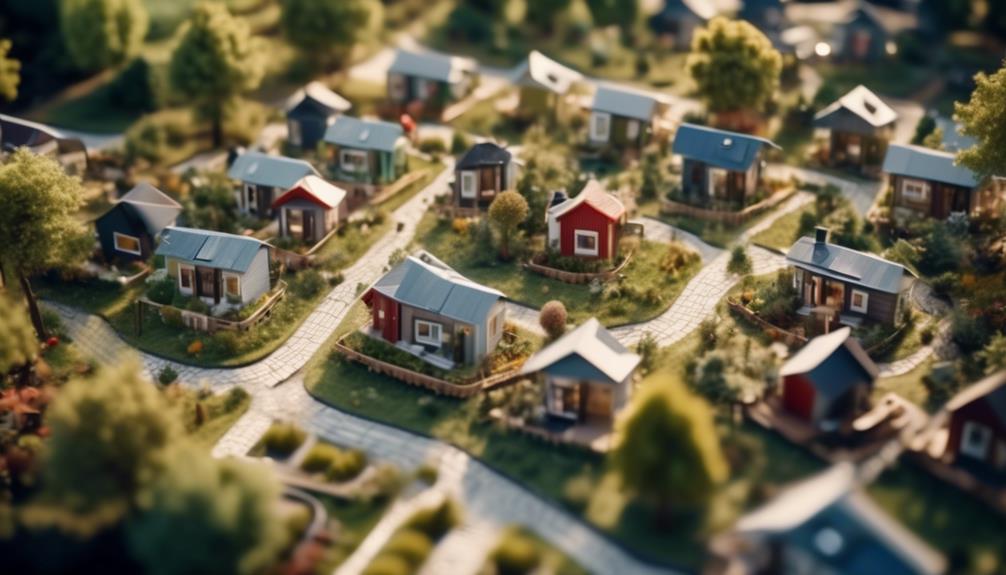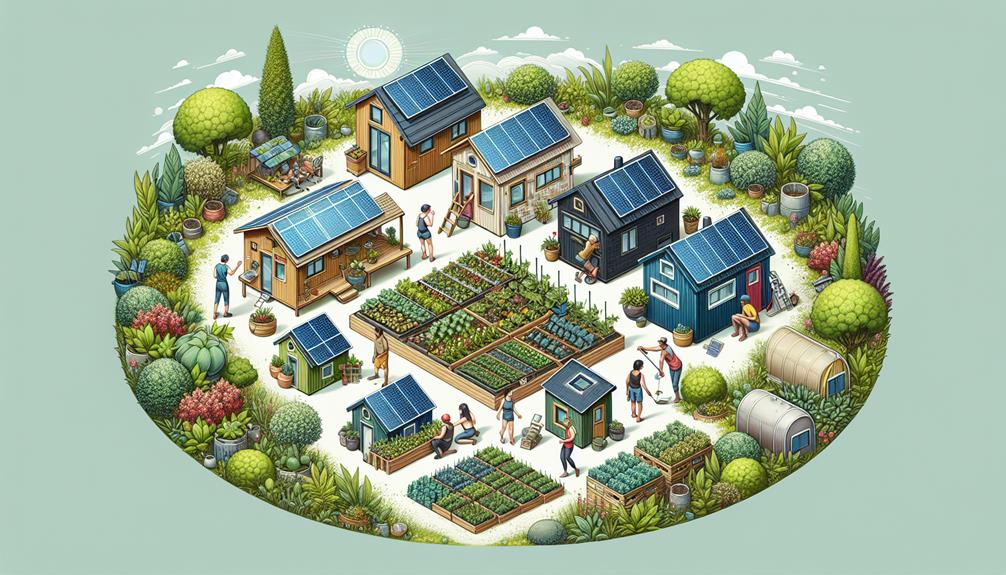Is it true that the adage 'less is more' can be realized through the creation of a tiny home community?
You've likely heard the growing buzz around tiny living, but the leap from concept to creation is where you'll find the real substance. As you contemplate the potential for financial savings, a reduced ecological footprint, and a heightened sense of community, it's essential to understand the myriad steps involved in actualizing such a space.
From navigating the intricacies of zoning laws to laying the last shingle on your communal gazebo, this guide walks you through the journey with a measured hand.
Yet, even with a blueprint at your fingertips, you may wonder what unexpected challenges lie ahead and how your unique vision will come to life within the tapestry of tiny home living.
Key Takeaways
- Understanding local zoning laws and legal considerations is crucial for building a tiny home community.
- It is important to conduct thorough research on specific zoning laws and regulations in your area and consult legal experts to mitigate risks associated with land acquisition.
- Securing financing for land purchase is a key step, and exploring options such as green loans and grants can be beneficial.
- When designing the community layout, it is important to navigate zoning and legal constraints, maximize space efficiency, and establish clear community guidelines and expectations.
Understanding Zoning Laws
Before you embark on establishing a tiny home community, it's crucial to navigate the intricacies of local zoning laws that dictate land use and building requirements. These laws are pivotal in determining where you can buy land and erect new tiny houses.
As you delve into Tiny House Building, you'll find that zoning laws vary widely, so it's imperative to understand the specific regulations in your area. You might consider hiring a consultant to streamline the process of securing the permits you need.
Adherence to building codes ensures that your innovative community not only fosters sustainability but also complies with safety standards. As pioneers in the tiny home movement, you'll live together in a testament to efficient design and responsible living.
Securing Land Acquisition
You'll need to navigate the complexities of zoning and legal considerations to ensure your land purchase aligns with tiny home community objectives.
Securing financing for the land acquisition is crucial; investigate green loans and grants that support sustainable development.
Zoning and Legal Considerations
To ensure compliance with local ordinances, frequently start your land acquisition process for a tiny home community by researching the specific zoning laws and regulations. Here's a succinct guide:
- Investigate the minimum square feet requirements for dwellings to ensure your tiny house design meets local standards.
- Assess the availability of utilities and infrastructure that align with sustainable building materials and practices for your custom tiny home.
- Secure the necessary permits and understand the building process, including inspections and code compliance for tiny home communities.
- Consult with legal experts who specialize in zoning and legal considerations for building a tiny house, mitigating risks associated with land acquisition.
These steps are vital to pioneering an innovative, legally-sound tiny house community that embodies technical precision and sustainable living.
Financing Land Purchase
Securing the right financing for your land purchase is a crucial step in actualizing the vision of a sustainable tiny home community. You'll need to explore various options for financing, including construction loans that encompass both land acquisition and building expenses. Consult with financial experts to secure financing that aligns with your project's innovative design and sustainable focus.
Before embarking on this journey, determine the total cost, factoring in zoning laws and permit requirements. Unlike a traditional home, your average tiny dwelling, especially those on a tiny house trailer, can significantly save money. However, building your tiny community requires a strategic financial plan.
Research thoroughly to understand all possibilities and consult professionals to make an informed decision that brings your sustainable community to life.
Designing the Community Layout

You'll need to navigate zoning and legal constraints to create a layout that aligns with municipal codes while fostering a sustainable tiny home community.
Focus on maximizing space efficiency without sacrificing the quality of living or environmental integrity.
Innovative design principles can help you utilize shared spaces and green infrastructure to enhance community interaction and minimize ecological impact.
Zoning and Legal Considerations
Navigating the complex web of local zoning laws is a crucial first step in designing a sustainable and legally compliant tiny home community layout. Here are the steps you'll take:
- Research Zoning Laws: Dive into the zoning and legal considerations specific to your area. Each locality has its own rules governing tiny house communities.
- Design Within Restrictions: Innovate within the constraints to create a layout that maximizes space and adheres to regulations, including parking spots and common areas.
- Permit Acquisition: Secure all necessary permits for home construction, ensuring your build process from start to finish is above board.
- Legal Compliance: Consult with legal professionals to ensure your tiny house on wheels or foundation homes meet all legal standards for utilities and infrastructure.
This comprehensive guide ensures your vision is both pioneering and permissible.
Maximizing Space Efficiency
When designing the layout of a tiny home community, strategically maximize space efficiency to foster sustainable living and enhance resident interaction. Optimize your tiny house floor plan to use every square footage cleverly. Incorporate stairs or ladders that double as storage to live in a tiny space without compromise. Prioritize space efficiency with multi-functional furniture and built-ins.
Plan communal areas to encourage outdoor activities, using shared resources to promote eco-friendly living. Insulate your tiny homes well to reduce energy needs. Position windows and doors to capitalize on natural light, cutting down on electricity usage.
Establishing Community Guidelines
Establishing community guidelines ensures that all members share a clear understanding of expectations and responsibilities, particularly regarding the use of communal spaces and resources. When you're building your tiny house community, it's crucial to make sure everyone is on the same page. To achieve this, consider:
- Drafting a detailed plan that addresses behavior and communal living expectations.
- Incorporating sustainable practices to reflect the eco-conscious spirit of the tiny house movement.
- Outlining conflict resolution and decision-making processes to maintain harmony.
- Emphasizing inclusivity and respect, fostering a cooperative environment.
Hiring a professional with experience in establishing community guidelines can help you find the right balance between technical accuracy and innovative design. This new approach ensures your tiny house community thrives sustainably.
Financing the Development

To successfully finance the development of a tiny home community, you'll need to research and compare various loan options, factoring in the costs of land acquisition, construction, and necessary permits.
With a sustainable focus, you should create a comprehensive budget that meticulously accounts for every dollar spent. Financing the development requires innovation, as you'll save thousands of dollars compared to traditional housing projects.
By choosing a loan that aligns with the Tiny Life ethos, you can build your home and community with a smaller ecological footprint.
As you're ready to start, remember to seek professional guidance. This technical support can be invaluable in navigating the complexities of construction loans.
Follow this step-by-step guide, and you'll be on your way to build their dream tiny house from start to finish.
Building and Infrastructure Setup
Initiating the building and infrastructure setup for your tiny home community involves choosing the right foundation to support your sustainable living goals. As you start building, it's time to plan the key details:
- Foundation and Floor:
Whether you're pouring a concrete foundation or equipping a trailer with undercarriage flashing, ensure a robust base for your tiny houses. The house floor needs to be solid, incorporating innovative materials like a reflection barrier for energy efficiency.
- Utility Connections:
Methodically install plumbing and electrical systems. High-quality electrical outlets and switches are crucial for safety and functionality.
- Energy Solutions:
Integrate solar panels to harness renewable energy, aligning with your sustainable focus.
- Durable Exteriors:
Choose advanced roofing material that promises longevity and complements the innovative design of your community structures.
Every step reflects technical precision, underlining your commitment to sustainable and innovative living.
Frequently Asked Questions
How to Build a Tiny House Step by Step for Beginners?
You'll start by learning design considerations, budget planning, and material selection. Invest in eco-friendly options and DIY kits for space optimization, navigate zoning laws, acquire building permits, and explore custom interiors and off-grid systems.
How Many Tiny Houses Can You Fit on 1 Acre of Land if Building a Small Community?
You'll navigate zoning considerations, optimize land utilization, and address privacy with a smart community layout. Balancing shared amenities, legal restrictions, and infrastructure planning is key, while minimizing environmental impact and ensuring design uniformity and diverse ownership models.
What State Has the Most Tiny Home Communities?
You're in luck; California leads with the most tiny home communities, pioneering in sustainable living, innovative design, and utility solutions despite zoning challenges and evolving tiny home legislation. Explore diverse ownership models and social dynamics there.
Does a Tiny House Need a Foundation?
You don't always need a foundation, but zoning challenges and building codes might require one. Consider foundation types for structural stability, anchoring systems for safety, and insulation strategies tailored to your climate's needs.
Conclusion
You've journeyed through the technical maze and emerged with a blueprint for sustainable living. Your dream of a cozy hamlet with kindred spirits is taking shape.
By embracing innovative design and staying eco-wise, you've planted the seeds for a greener tomorrow. Financial liberation and heartfelt connections await in your new tiny home community.
So, take a deep breath and watch as your shared vision blossoms into a thriving, pint-sized paradise.
Welcome home.

